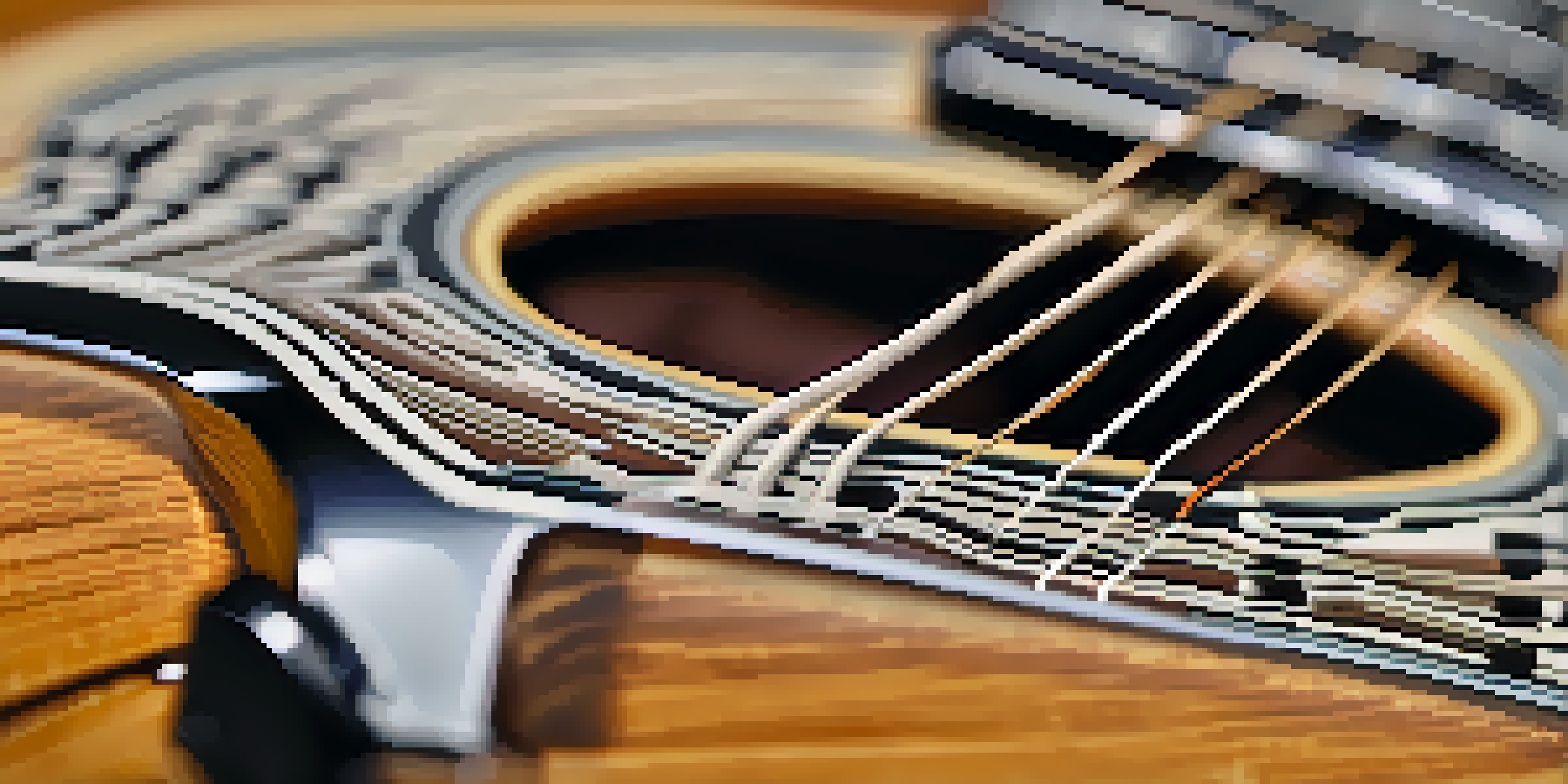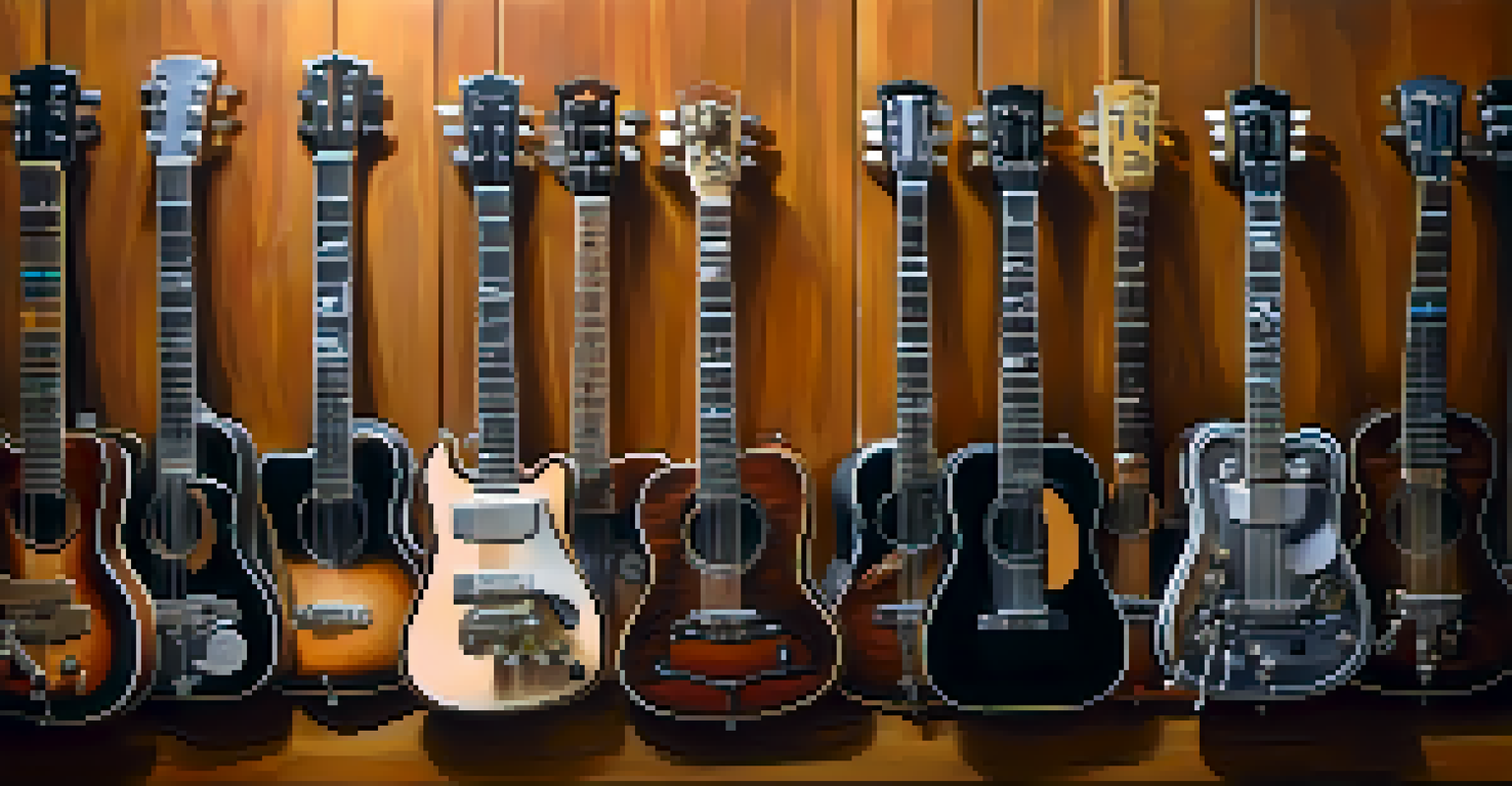Understanding Guitar Capos: A Key to Versatile Playing

What is a Guitar Capo and How Does It Work?
A guitar capo is a simple yet powerful device that clamps down on the strings of a guitar, effectively shortening their length. By doing this, it raises the pitch of the strings, allowing you to play in different keys without changing your finger positioning. This means that instead of learning new chord shapes, you can use familiar ones, making it easier to play songs in various styles.
A guitar is more than just a collection of wood and strings; it’s a tool of expression and creativity.
Imagine you’re at a jam session, and someone asks you to play a song in a different key. If you have a capo handy, you can quickly adjust to the new key without missing a beat. It's like having a magic wand that transforms your guitar’s sound, making it a favorite tool for many musicians.
Essentially, a capo acts like a movable nut, allowing you to change the pitch without having to re-tune your guitar. This flexibility is invaluable for songwriters and performers who want to explore new musical territories.
Types of Guitar Capos: Finding Your Fit
There are several types of guitar capos available, each designed for different playing styles and preferences. The most common types include the trigger capo, which is easy to use with one hand, and the strap capo, which provides a more customized fit for various neck widths. Then there are partial capos that only clamp down on certain strings, offering unique voicings and sounds.

Choosing the right capo for your guitar can enhance your playing experience significantly. For instance, if you play a lot of fingerstyle music, a partial capo might allow you to create interesting harmonies and textures that a standard capo wouldn’t. It’s all about finding the right tool for the sound you want to achieve.
Capos Simplify Key Changes
A guitar capo allows musicians to easily change keys while using familiar chord shapes, enhancing versatility in playing.
In addition, consider the material and build of the capo. Metal capos tend to be more durable, while rubber or silicone options can provide a gentler touch on the strings. Ultimately, the best capo is one that feels comfortable in your hands and suits your musical needs.
Benefits of Using a Capo in Your Playing
Using a capo opens up a world of possibilities for guitarists. One significant benefit is the ease of playing in different keys, which can be a game-changer during live performances or songwriting sessions. This tool allows you to maintain the original chord shapes you love while exploring various harmonies and melodies.
The beauty of music is that it can be made with simple tools, like a capo, that open doors to endless possibilities.
Moreover, capos can help you sing songs that might otherwise be out of your vocal range. By repositioning the capo, you can find a key that complements your voice perfectly. This aspect is especially useful for singer-songwriters who want to accompany themselves without straining their vocals.
Additionally, a capo can inspire creativity. When you play the same chords in a different key, it can spark new ideas and arrangements, leading to fresh sounds and compositions. You might just find your next favorite riff by experimenting with a capo!
How to Properly Use a Capo for Best Results
To get the most out of your capo, it’s crucial to place it correctly. Ideally, the capo should be positioned just behind the fret, ensuring that it presses down the strings firmly without causing any buzzing. This placement allows for clear notes and better intonation, which is vital for a harmonious sound.
When using a capo, it’s also important to check your guitar’s tuning. Sometimes, the pressure from the capo can slightly alter the tuning, especially if it’s a tight fit. Taking a moment to tune your guitar after placing the capo can help maintain that sweet sound you’re aiming for.
Different Capo Types Available
Various capo types cater to different playing styles, from quick-release options to partial capos for unique sounds.
Lastly, don’t hesitate to experiment with different placements along the neck. Each fret can give you a unique tonal quality, so find what works best for the song you’re playing. The beauty of a capo lies in its versatility, so play around with it and discover new sounds!
Capos and Different Guitar Styles: A Perfect Match
Guitar capos are not just for folk or acoustic music; they can enhance a variety of genres. For example, in country music, capos are often used to achieve that bright, ringing sound that complements the storytelling lyrics. Many country artists swear by their capos, as it allows them to play more complex harmonies effortlessly.
Similarly, in pop music, where catchy melodies are essential, using a capo can help create those singable hooks without the need for advanced chord shapes. It simplifies the playing process and keeps the focus on the melody, making it accessible for all skill levels.
Even in rock and blues, capos can be beneficial. Many famous songs feature capos, allowing guitarists to achieve a specific sound or mood. It’s a testament to how versatile this tool is, adapting to different styles and enhancing your overall playing experience.
Common Misconceptions About Guitar Capos
One common misconception is that using a capo is a crutch for less skilled guitarists. In reality, it’s a legitimate tool used by musicians of all levels to expand their creativity and sound. Just like using a metronome or a tuner, a capo is simply another resource in your musician's toolkit.
Another myth is that capos can only be used on standard tuning. While they are primarily designed for standard tuning, capos can work wonders on alternate tunings too. Many musicians enjoy experimenting with different tunings and find that a capo can help them achieve unique sounds across various styles.
Capos Enhance Musical Creativity
Using a capo can inspire new ideas and arrangements, encouraging guitarists to explore diverse musical avenues.
Lastly, some believe that capos limit your playing options. In truth, they can open new doors to creativity. By changing keys without learning new chords, you can explore different musical avenues and discover sounds you may not have previously considered.
Tips for Choosing the Right Capo for Your Needs
When selecting a capo, start by considering your guitar type. For example, if you play a classical guitar, look for a capo that is designed specifically for nylon strings, as it will provide a gentler grip. On the other hand, if you have an electric guitar, a metal capo may be more suitable for its sturdiness and durability.
Next, think about your playing style and preferences. If you frequently switch between keys, a quick-release trigger capo might be your best bet. However, if you enjoy experimenting with different tunings and voicings, investing in a partial capo could be worthwhile.

Finally, don’t forget to read reviews and try out different models if possible. A capo is a personal accessory, and what works for one guitarist may not work for another. Finding the right fit can make a significant difference in your playing experience, so take the time to explore your options.